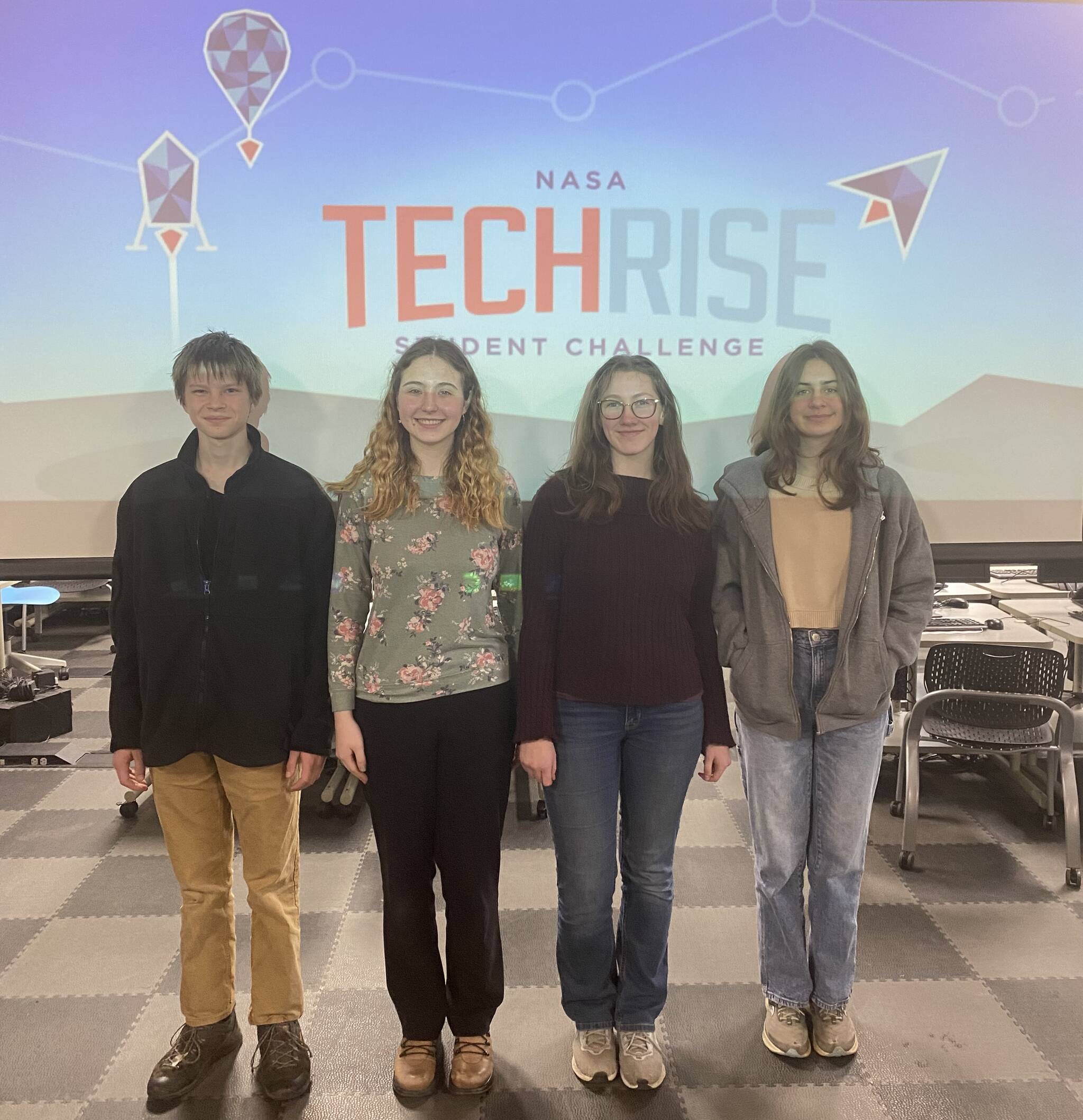On Jan. 23, NASA announced the 60 winning teams in their third annual Techrise Challenge, including four students from Friday Harbor High School. This year’s Techrise Challenge invited teams of sixth to 12th grade students from private, public and charter schools across the country to create their own project proposal to be launched on a high-altitude balloon or rocket-powered lander. Winning teams receive $1,500 to build their projects, mentorship from NASA engineer-advisors, and are tested on a NASA-sponsored commercial flight.
Last September, FHHS CTE teacher Sam Garson informed his students of the competition and encouraged them to participate. Kira Clark (junior), Grayson Matthews (sophomore), Megan Mellinger (junior) and Flora Vaugn (sophomore) rose to the challenge and began working on their proposal. As the first group of FHHS students to participate in the Techrise Challenge, each of them holds a special interest in science and engineering, and were eager for more real-world application.
“I have always loved science, and I wanted to get more into engineering,” said Mellinger. “I figured it would be a great hands-on way to actually experience the engineering process.”
“I feel like in science classes, you memorize a bunch of facts, but that’s not really the process of science,” said Vaughn. “That’s what really appeals to me with projects like these.”
The group began meeting weekly on their own time to discuss their project. Since they are all members of TSA, Technology Student Association, it made it easy for them to commune after the club’s Wedneday meetings. The group also shares many classes together, making it convenient to discuss their project during these classes, at lunch, or in the library.
NASA provides a variety of different resources and brainstorming materials to get the students started on the challenge, but a majority of the project requires additional research. Matthews mentioned his gratitude for the teachers who offered their guidance during the process.
“We have really good teachers here. If you have an idea, they can try to point out any flaws and what you may be trying to accomplish, or otherwise make suggestions,” said Matthews.
The Techrise Challenge proposes numerous experiment ideas for students to consider, including experiments on thermodynamics, greenhouse gasses, air quality, and more. The FHHS team chose to explore radiation and the ability of different materials to reflect or shield against radiation and UV rays. They were interested in radiation shielding and its application in space travel and missions, as astronauts are exposed to intense UV levels when they are working outside of a spacecraft. Additionally, the group is interested in applying their research to radiation shielding in medical facilities, such as X-ray radiation, and the use of reflection and shielding on roofs to maintain cooler temperatures in buildings.
After two months of collaboration, the team submitted their final proposal by Nov. 13, and they waited another two months for the results. The students were ecstatic to receive recongition for their efforts on a national level, being selected as one of 30 teams to have their project be launched from a high-altitude balloon and receive funding and guidance from NASA professionals.
“It’s really awesome to see all of our work paying off, despite there being bumps in the road,” said Vaughn. On a similar note, Matthews commented, “We get told about so many opportunities to compete in, so it’s really inspiring for us and other students at our school to show that you can win these competitions and that [your] effort does pay off.”
Clark mentioned her anticipation in progressing forward with the project and reporting their findings. “I’m really excited to see what kind of data we can collect and what the results are. I think it’s awesome that we get to actually complete the experiment,” said Clark.
In terms of next steps, the students and Mr. Garson had their first meeting with their NASA mentors the week following the announcement of the winners, outlining the process from now until the experiment launch this summer, as well as deciding when to hold their weekly touch-base with the NASA engingeers. They also have access to a guideline that includes weekly benchmarks they should be reaching throughout the project’s construction. According to the team, their first steps involve planning how to assemble their project, gathering needed materials, and figuring out how they will be sending their data.
As the educator sponsor for the team, Garson is incredibly impressed and proud of the students and their efforts, and is excited that students have been getting involved in different competitions in recent years.
“More and more students are starting to respond [to opportunities] and see that even on our rural little island, we compete on a national level. Our students are pretty incredible human beings who get recognition for the hard work they do,” said Garson. “It’s every teacher’s dream to be like, ‘hey, here’s this opportunity,’ and to watch them run with it.”
The team has until mid-May to complete and submit their project, and it will be displayed at a winner’s showcase before it is launched on a NASA high-altitude balloon this summer. In the meantime, the students will balance course work, athletics, and other extracurricular activities on top of constructing their project, going above and beyond expectations. As Matthews put it, “Apart from what you learn [from the process] and the academic credibility you gain from it, it is also a testament to your character… you’re actively working to progress yourself.”




